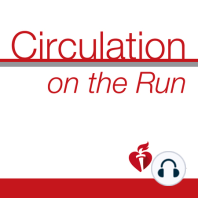20 min listen
Circulation February 12, 2019 Issue
ratings:
Length:
22 minutes
Released:
Feb 11, 2019
Format:
Podcast episode
Description
Dr Carolyn Lam: Welcome to Circulation on the Run, your weekly podcast summary and backstage pass to the journal and its editors. I'm Dr Carolyn Lam, Associate Editor from the National Heart Center and Duke National University of Singapore. Dr Greg Hundley: And I'm Dr Greg Hundley, director of the Pauley Heart Center from VCU Health in Richmond, Virginia. Dr Carolyn Lam: Is income volatility a new cardiovascular risk factor? You have to stay tuned to hear all about that. But for now, join Greg and I over a nice little coffee chat, because we're picking up the journal right here and I'm going to tell you about our two top picks this week. Greg, you go. Dr Greg Hundley: Well my top picks, Carolyn, is really pertaining to senescence and senescent cardiomyocytes. Remember that? Senescence is a situation where there's a mismatch between energy demand and supply and so that facilitates the cells transitioning toward failure. They lose their ability to function. In other parts of the body, they lose their ability to divide. And these investigators assessed altered calcium transfer from sarcoplasmic reticulum to the mitochondria, because that's being casually linked to the pathophysiology of aging in heart failure. Because the advanced glycation end products or AGEs accumulate through life, the authors thought that maybe this intracellular glycation would be occurring in aged cardiomyocytes and their impact on the sarcoplasmic reticulum and mitochondria. So, their study, they investigated both mice and humans and the found that ryanodine receptor glycation was associated with more pronounced calcium leak in mice and also interfibrillar mitochondria directly exposed to sarcoplasmic calcium release from aging mice had increased calcium content, compared to those with younger ones. Now we're starting to implicate a mechanism by where senescence could be important in these mice. But of course, in Circulation in these wonderful basic science papers that we have, they also cover a translational human component. And what these group found is that there were higher levels of advanced glycation end products and reduced glyoxalase 1 activity present in left atrial appendages, from those patients that underwent surgery greater than 75-years-of-age, compared to individuals that were younger. And also, elderly patients exhibited hyper glycation and increased mitochondrial calcium content that was associated with reduced myocardial aerobic capacity due to less respiring mitochondria. Dr Carolyn Lam: Wow Greg, that was a huge summary and how nice to link aging or senescence with AGE or advanced glycation end products. Seriously, that was new to me. Okay look, bring it home. What are the clinical implications? Dr Greg Hundley: What these investigators have done is now identified a previously unknown pathophysiological mechanism that may facilitate the transition from healthy, towards failing cardiomyocytes and the implication is that if you could disrupt that process, maybe you could halt the aging of cardiomyocytes. You got to be careful though I think with senescence, just as we know from the general literature. Senescence is a defense mechanism in cancer therapy, but it's a protagonist if you will, in aging. More to come in this field, but very exciting research. So Carolyn, tell me about your first paper. Dr Carolyn Lam: Happily, Greg. I'm going to take us to the cath lab and talk about functional assessment of epicardial coronary artery disease. This paper from Dr Koo and colleagues of Seoul National University Hospital, is the first to validate the physiological relevance and prognostic implication of all available novel resting pressure derived indices of coronary stenosis. This includes indices like rest
Released:
Feb 11, 2019
Format:
Podcast episode
Titles in the series (100)
Circulation December 19/26, 2017 Issue: Circulation Weekly: Your Weekly Summary & Backstage Pass To The Journal by Circulation on the Run
